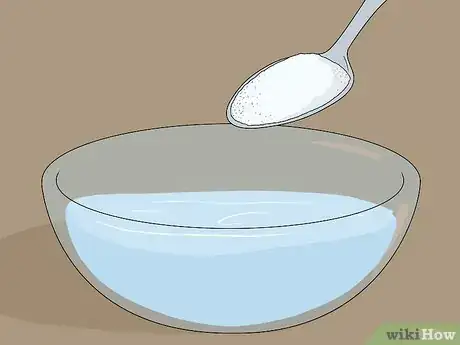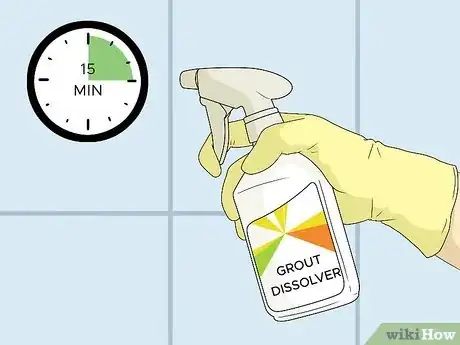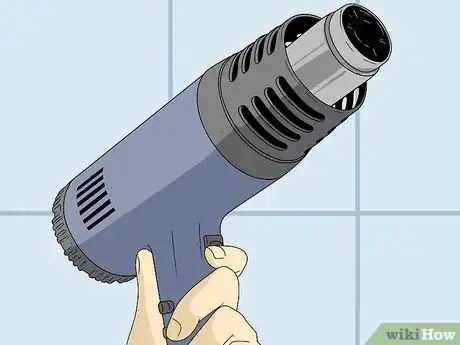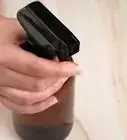This article was co-authored by wikiHow staff writer, Hunter Rising. Hunter Rising is a wikiHow Staff Writer based in Los Angeles. He has more than three years of experience writing for and working with wikiHow. Hunter holds a BFA in Entertainment Design from the University of Wisconsin - Stout and a Minor in English Writing.
There are 11 references cited in this article, which can be found at the bottom of the page.
This article has been viewed 4,074 times.
Learn more...
Do you want to update the look of discolored or damaged grout between your tiles? Even though grout comes out pretty easily, softening it beforehand makes the process even quicker. Using liquid grout softeners works best for floor tiles since it has more time to soak in, but heat treatments work well for softening grout on your walls. Keep reading, and we’ll help you find the perfect solution to get that old grout out.
Things You Should Know
- Soften grout on floor tiles by soaking it with sugar water, a lemon juice solution, or a vinegar solution for 10–20 minutes.
- For a stronger way to break down grout, use a chemical remover like sulfamic acid or grout dissolver spray instead.
- Warm up grout on wall tiles with a blow dryer or heat gun. Alternatively, use a steam cleaner to soften the grout.
Steps
Liquid Grout Softeners
-
1Sugar water
Dissolve 1 cup (200 g) of white granulated sugar in 1 US gal (3.8 L) of warm water. Then, just pour the sugar water directly on the grout lines and let it sit for 10–20 minutes before you try removing the grout. If the grout dries out, just add more sugar water[1]- Clean your tiles afterward since the sugar water can leave behind a sticky residue.
- Sugar water is slightly corrosive, so it breaks down the grout to make it easier to scrape out.
-
2Lemon juice and water
Make a solution that’s 1 part lemon juice and 2 parts warm water, and pour it directly on the grout that you want to remove. Let the solution soak on the grout for about 10–20 minutes to help it soften up.[2]- Lemon juice is acidic and eats through the grout so it breaks down faster.
Advertisement -
3Vinegar
If there’s a slight layer of haze on your tiles leftover from when you installed grout, wet a clean cloth with distilled white vinegar. Rub the vinegar onto the tiles and grout. Let the vinegar sit for about 5–10 minutes. Then, scrub at the grout to clean it off the tile.[3]- Vinegar may discolor your tiles, so test it on a small patch of tile that’s not noticeable before you spread it onto your grout.
- After you finish softening the grout be sure to wipe the area with a sponge and clean water.
-
4Sulfamic acid solution
Wear rubber gloves and safety glasses before working with sulfamic acid. Mix about 6–12 ounces (170–340 g) of the sulfamic acid with 1 gallon (3.8 L) of water. Apply the solution to the grout and let it sit for about 30 minutes before scraping out the grout.[4]- Avoid using sulfamic acid on natural stone tiles since it could leave etch marks on the surface.
-
5Chemical grout dissolver spray
Start by wetting the grout with clean water first so it’s saturated. Put on a pair of rubber gloves and after about 15 minutes, apply the dissolver spray directly to the grout. Wait another 20–30 minutes before removing the grout.[5]- Dissolver sprays use acids that eat through grout to soften it.
Softening Grout with Heat
-
1Blow dryer
Set your blow dryer to the highest heat setting and hold it about 8 inches (20 cm) away from the grout. Turn it on and point it directly at the grout lines for about about 3 minutes to help soften them.[6]- If the grout cools down before you get a chance to remove it, just warm it up again for a few more minutes with your blow dryer. It usually takes 5 minutes or so to harden back up completely.
-
2Steam cleaner
Hold the narrow nozzle of the steam cleaner about 1–2 inches (2.5–5.1 cm) over your grout lines. Turn on your steam cleaner and spray a 1–2 ft (30–61 cm) section of tiles so the heat and moisture soften the grout.[7]- If your steam cleaner has a nylon brush attachment, put it on the tip to help scrub off the top layer of grout.
-
3Heat gun
Turn your heat gun onto a setting that’s around 500 °F (260 °C) and hold it about 8 inches (20 cm) away from your tiles. Direct the heat toward the grout lines and warm it up for 2–3 minutes. After that, the grout should be soft enough for you to easily remove.[8]- Be careful using a heat gun on soft glazed tiles since it could cause damage.
Tools for Removing Grout
-
1Scrape out the grout by hand with a grout saw. Place the blade of the grout saw in the line between your tiles. Apply gentle pressure as you move the saw back and forth to cut through the grout. Keep scraping along the grout lines until you completely remove it.[9]
- Grout saws have a small serrated blade that grinds the grout out from between your tiles.
- Move the grout saw slowly so the blade doesn’t slip out and scratch your tiles.
-
2Chip out stubborn grout with a hammer and chisel. If there are hardened pieces stuck between your tiles, put the tip of your chisel against the edge of your grout. Lightly tap the end of the chisel’s handle with your hammer to break the grout apart.[10]
- Try wetting or heating up the grout before using a chisel so you don’t need to hit as hard, making it less likely you’ll damage any nearby tiles.
-
3Cut through the grout with an oscillating tool for the quickest removal. Use a carbide blade specifically made to cut through the grout. Hold the edge of the blade against the grout line, and turn on the tool. Use the oscillating tool by pressing the blade into the grout and slowly moving it along the lines between your tiles.[11]
- Wear a face mask and safety glasses when you use an oscillating tool to protect yourself from dust and small pieces of grout.
References
- ↑ https://thehomeatlas.com/how-to-soften-grout-for-removal/
- ↑ https://thehomeatlas.com/how-to-soften-grout-for-removal/
- ↑ https://laticrete.com/~/media/support-and-downloads/technical-datasheets/tds400-pro.ashx?la=en
- ↑ https://www.custombuildingproducts.com/TDS/TDS-139.pdf
- ↑ https://www.a-lok.com/pdf/kellysconcretedissolver.pdf
- ↑ https://thehomeatlas.com/how-to-soften-grout-for-removal/
- ↑ https://thehomeatlas.com/how-to-soften-grout-for-removal/
- ↑ https://cdn.laticrete.com/~/media/support-and-downloads/technical-datasheets/tds111.ashx
- ↑ https://www.ronhazelton.com/projects/how_to_clean_tile_grout




































































